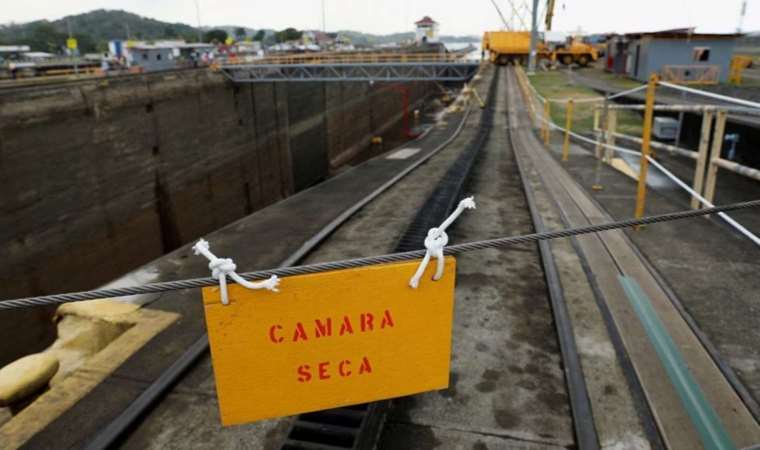Drought, hot seas cause delays at Panama Canal
Before the Ever Max could make its first Panama Canal voyage this month, a historic drought forced it to reduce its weight by unloading hundreds of containers.

On August 1, adverse weather conditions foiled the vessel, owned by Taiwanese shipping company Evergreen Marine, in its attempt to set a new record for transporting the highest number of containers through the crucial maritime shortcut linking the Pacific and Atlantic oceans.
The Panama Canal Authority has taken measures to preserve water, including reducing maximum ship weights and daily ship crossings. This development raises concerns among maritime transportation experts who anticipate such occurrences might become the new norm. The backdrop to this concern is the deficit in rainfall in what is the fifth wettest country globally. This situation has spotlighted climate risks impacting the ocean shipping industry, which facilitates 80% of global trade.
Ship owners now face several choices. They can either decrease cargo loads, opt for alternative routes that may add thousands of miles to the journey, or grapple with queues that recently led to a backlog of 160 vessels, causing delays of up to 21 days for some ships.
These restrictions are already causing China-U.S. spot shipping prices to surge by up to 36%. This rise is attributed to soaring sea temperatures, which climate scientists warn could intensify extreme weather events.
Drew Lerner, founder and senior agricultural meteorologist at World Weather, whose clientele includes global commodity traders, cautions, "Given how significantly the temperatures exceed the norm, we must be vigilant."
In navigating these challenges, canal operators are walking a tightrope as they strive to manage disruptions in maritime trade and prepare for an anticipated drier period in the upcoming year. Peter Sand, Chief Analyst at Xeneta, an air and ocean freight rate benchmarking platform, remarks on the delicate balance they are attempting to maintain.
The year 2022 witnessed over 14,000 ships traversing the canal. Among these, container ships are the most prevalent users of the Panama Canal, responsible for transporting over 40% of consumer goods traded between Northeast Asia and the U.S. East Coast.
Ships bound for the U.S. that are ensnared in these bottlenecks have transported a diverse range of goods including Barbie dolls, auto parts, BYD solar panels, water treatment equipment, and diabetes testing kits. This information is derived from data provided by Steve Ferreira, CEO of a company specializing in auditing ocean shipping bills.
Restrictions at the canal commenced earlier this year, affecting approximately 170 countries and virtually all types of commodities. Notable items impacted include soybeans and liquefied natural gas from the United States, copper and fresh cherries from Chile, and beef from Brazil.
The ramifications extend to bulk carriers that handle commodities ranging from corn to iron ore, as well as tankers transporting oil, fuel, gas, and chemicals. Energy companies are rerouting vessels laden with coal and liquefied natural gas to the Suez Canal.
Monitoring Water Levels The ongoing El Niño climate pattern, characterized by elevated temperatures in the central and eastern tropical Pacific Ocean, is contributing to Panama's drought conditions.
In the vicinity of the canal, the country is grappling with one of the driest years in its 143-year record-keeping history. Data from the canal authority and the Smithsonian Tropical Research Institute (STRI) underscore the fact that rainfall measurements in the region are currently 30-50% below the norm.
Even during the current rainy season, water levels in Gatun Lake— the primary reservoir fed by rainfall that facilitates ships' transit through the Panama Canal's lock system—remain lower than expected.
STRI's Steven Paton highlights that a potentially early commencement of Panama's dry season and higher-than-average temperatures, characteristics often associated with major El Niño events, could exacerbate evaporation from Gatun Lake. This, in turn, could lead to near-record low water levels by March or April 2024.
Patton emphasizes, "We're witnessing a convergence of multiple factors," underscoring his more than three-decade-long observation of rainfall patterns in the Central American nation.
Over the last 25 years of the canal's 109-year history, the frequency of major El Niño-related dry patterns has notably increased. If this trend persists, Paton warns that guaranteeing passage for the largest ships could become increasingly challenging for the Panama Canal.
Preparations and Challenges Operators of the canal have been compelled to impose lower ship weight limits due to reduced water depth, posing challenges for sizable vessels like the Ever Max.
Though the ship was designed to accommodate more than 8,650 40-foot (12-meter) cargo containers, it arrived on the Pacific side of the canal exceeding the weight limit, even with a load equivalent to 7,373 containers.
Subsequently, around 700 containers were offloaded onto trains, then retrieved on the Atlantic side before continuing the journey to the U.S. East Coast. This information is based on data from the Canal Authority and Eikon vessel tracking. Ship owner Evergreen Marine (2603.TW) declined to provide comments.
Furthermore, operators of the canal have also instituted a reduction in the number of daily ship crossings, now set at 32 compared to the usual 36 during regular operations. Each passage consumes around 50 million gallons of water, only a portion of which is recycled.
Certain shipping executives are bracing for additional reductions later this year. They point out that in 2020, a less severe drought prompted canal operators to decrease daily crossings to 27.
Brian Bourke, Global Chief Commercial Officer at SEKO Logistics, emphasizes, "Any entity engaged in global product shipping should be vigilant regarding potential disruptions due to climate change. The Panama Canal's situation is just the latest illustration of this phenomenon."

En Çok Okunan Haberler
-
 Kayyum rektörün paylaşımına tepki
Kayyum rektörün paylaşımına tepki
-
 Kadınları 'çarşaf'a çağırdılar
Kadınları 'çarşaf'a çağırdılar
-
 Metin Külünk'ten, Şimşek'e 'fotoğraflı' uyarı
Metin Külünk'ten, Şimşek'e 'fotoğraflı' uyarı
-
 Altın fiyatları güne nasıl başladı?
Altın fiyatları güne nasıl başladı?
-
 Taksim bombacısı için karar çıktı
Taksim bombacısı için karar çıktı
-
 Mükemmel koca olan 4 burç
Mükemmel koca olan 4 burç
-
 Mersin’de hasat başladı: 150 bin ton rekolte bekleniyor!
Mersin’de hasat başladı: 150 bin ton rekolte bekleniyor!
-
 Özgür Özel 'kırmızı motosiklet' sözünü tuttu
Özgür Özel 'kırmızı motosiklet' sözünü tuttu
-
 Nihal Candan için yeni karar
Nihal Candan için yeni karar
-
 Perinçek’in danışmanı Adanur tutuklandı
Perinçek’in danışmanı Adanur tutuklandı

















